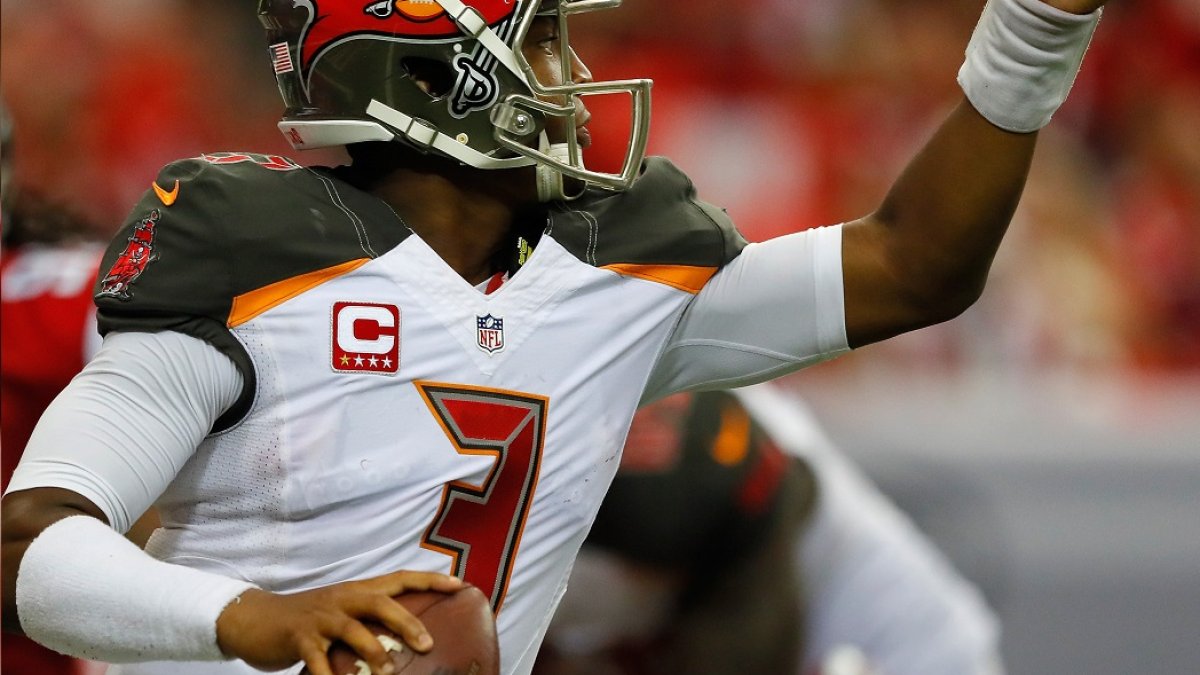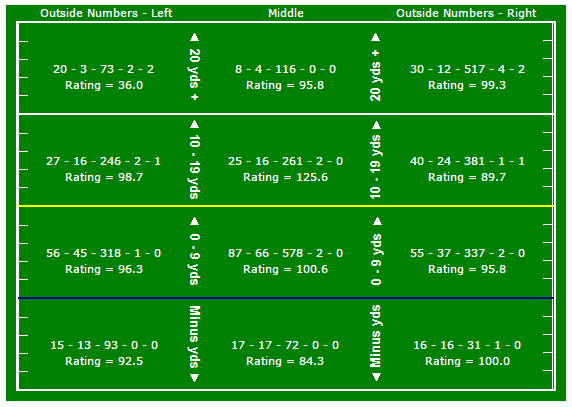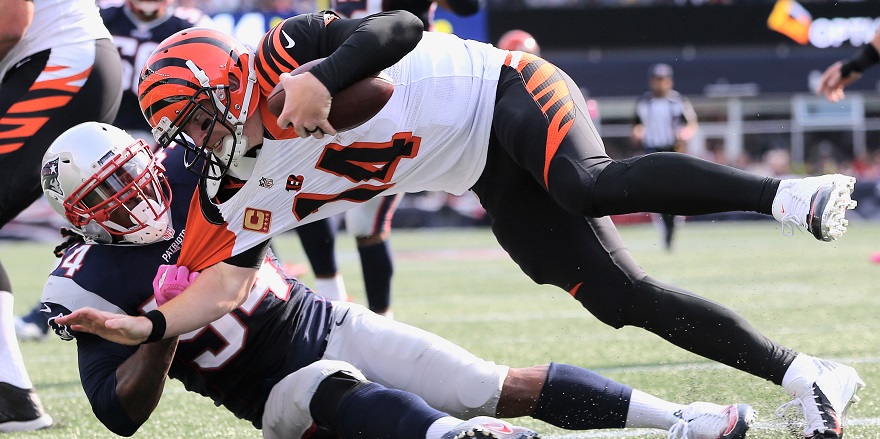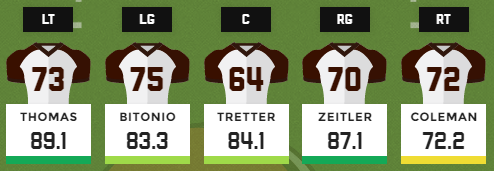If you play fantasy football anything like me, your roster will have a large majority of proven veterans, some young upside players with potential, and perhaps a rookie or two. Larry Fitzgerald isn’t a sexy name at this point in this career, but Fitzgerald owners from last season can attest that the 33-year old still had some moxie after averaging 15.3 PPR points per game (WR12).
Supplementing proven commodities with young, upside players is a great way to find a winning combination of safety and ceiling. Finding potential breakout players before your leaguemates is one of the most rewarding parts of playing fantasy football. Not only does it help your team become more successful, but these players often come at very affordable prices on draft day.
We’ve already covered breakout running backs and wide receivers in this space. Here are five quarterbacks with the potential for breakout campaigns entering 2017:
Jameis Winston, Tampa Bay Buccaneers
After notching QB13 and QB16 fantasy finishes to start his career, I’m not afraid to hitch my wagon to Winston as this year’s top breakout quarterback.
The Buccaneers have made it their mission this offseason to surround Winston with playmakers in an attempt to bring out the best of him. WR DeSean Jackson, TE O.J. Howard, and WR Chris Godwin were brought in to help improve a unit in dire need of playmakers. Anytime WR Adam Humphries finishes second on your team in targets, a massive overhaul should be on the way.
Winston should take off from a fantasy perspective given his plethora of options to target on any given play. Jackson’s speed notoriously opens up the field for all involved, making easier reads and larger windows for Winston to target. Mike Evans may see less volume, but could do more damage with higher efficiency. Only the Philadelphia Eagles ran more two-TE sets than Tampa Bay last year, so we should expect plenty of both Howard and TE Cameron Brate on the field together in 2017. Godwin primarily played as the X receiver on the outside at Penn State, but figures to be moved around the formation with the other starters to create mismatches.
Last year Winston saw an increase in nearly every counting stat. His completion percentage, touchdown rate, and passer rating were all on the rise. He finished with six weeks as a top-12 fantasy quarterback despite having few options to throw to. Tampa Bay provided Winston a complete overhaul, upgrading him with receivers capable of attacking the short, intermediate, and deep parts of the field.
A top-six finish isn’t outside his potential range of outcomes.
Tyrod Taylor, Buffalo Bills
The perpetually undervalued Taylor deserves some love here as a player with a ceiling we have yet to truly see. New OC Rick Dennison will bring balance to a team that has ranked first and second in run-play percentage during Taylor’s time as starting quarterback. This newfound freedom to throw the ball could put Taylor on an elevated fast path to fantasy stardom.
Over the last two years, Taylor has finished with 19.3 and 18.1 fantasy points per game. Those are pretty remarkable numbers. His best receiver, WR Sammy Watkins, has only played in 19 of the 29 possible games they could’ve played together. Taylor now gets some additional help with second-rounder Zay Jones out of East Carolina. Jones thrived as an intermediate target at ECU, finishing with a 0.43 market share of receiving yards and 0.31 market share of receiving touchdowns en route to a 158-1,746-8 stat line. Jones and Watkins should thrive immediately as intermediate targets in Dennison’s West Coast offense. It just so happens that’s exactly where Taylor makes his best plays:
Taylor also comes with the built-in safety of a rushing floor. Over the past two years, Taylor leads all quarterbacks with 14 games with at least 40 yards rushing. That’s essentially an extra four-point passing touchdown built into his fantasy score before taking passing statistics into account. 14 of his 29 games – 48.3 percent – provide that safety net with him consistently provided additional fantasy points on the ground.
Taylor’s current MFL10 ADP is QB18. That is remarkably low for a quarterback of Taylor’s ilk, and a screaming value. He doesn’t face a particularly daunting schedule with just the Patriots and Broncos ranking in the bottom-10 of fewest points allowed to opposing quarterbacks last year. Given the Bills’ desire to become more balanced on offense this year, expect a breakout performance from Taylor at a significantly discounted price.
Eli Manning, New York Giants
I’m floored that Manning isn’t being talked about heavily. Over this past offseason his team picked up WR Brandon Marshall and selected TE Evan Engram in the first round of the draft. Marshall had a down year with the Jets last season, but it’s difficult to put all the blame on him considering who was throwing the ball. Despite the inefficiencies under center with the Jets, only Dez Bryant has more receiving touchdowns than Marshall over the past five seasons. Marshall is a touchdown machine and should elevate the ceiling of Manning.
Engram is another weapon that Manning now has it his disposal, and the 6-foot-3 hybrid tight end/wide receiver is going to be a matchup nightmare for opposing offenses. We can expect Engram to split out wide and either run past linebackers that try to cover him or punish the defensive backs that elect to take on those duties.
Manning’s bad rap as a fantasy quarterback is tragically misdirected. Since 2014 when Ben McAdoo joined the Giants, Manning has finished as the QB10, QB8, and QB21.
| Year | Cmp | Att | Cmp% | Yds | TD | TD% | Int | Int% | AY/A | Fantasy | Top-12 Wks |
| 2014 | 379 | 601 | 63.1 | 4410 | 30 | 5 | 14 | 2.3 | 7.3 | QB10 | 7 |
| 2015 | 387 | 618 | 62.6 | 4436 | 35 | 5.7 | 14 | 2.3 | 7.3 | QB8 | 8 |
| 2016 | 377 | 598 | 63 | 4027 | 26 | 4.3 | 16 | 2.7 | 6.4 | QB21 | 4 |
Last year was an outlier for Manning, and our brain’s tendency to focus only on the recent data has made Manning an incredible value with early QB16 ADP. The Giants have been in the top-12 in pass-play percentage two of the last three years. They rank top-five in red-zone pass-play percentage during that time span. This offense clearly wants to throw the ball, often, and that is why I’m expecting a bounceback year from Manning after such a low touchdown rate. Given his improved receiving corps, he has a very strong chance to surpass his ADP and be this year’s golden ticket late-round quarterback.
Andy Dalton, Cincinnati Bengals
It might be cheating to list a quarterback here that already has a top-five season under his belt (2013), but after several years as a fringe QB1/QB2, I think it’s time to anoint 2017 as the return of the red rifle.
Dalton just got a massive upgrade at receiver with first rounder John Ross and his 4.22 speed. TE Tyler Eifert has missed 11 games over the last two years combined, but still leads all tight ends in touchdowns over that span (18). A.J. Green played only 10 games last season, but was on his way to career-defining campaign. He was on pace for 106 receptions for 1,542 yards and 6 touchdowns — a top-five wide receiver finish. The Bengals also added RB Joe Mixon to the group and his diversity will allow him to enter the huddle without the Bengals tipping their hand to either a run or pass play.
One major reason I believe Dalton is a buy low is positive touchdown regression heading his way. Dalton posted a career-low touchdown rate of 3.2 percent last year, finishing with just 18 passing touchdowns. Prior to last season he had a career touchdown rate of 5.0 percent. Dalton has a 33-passing-touchdown campaign under his belt, so we know he is capable of putting up big numbers. He now has the weapons around him to repeat.
If this team can stay healthy, the offense has plenty of firepower to contend for a playoff spot in the AFC North. We could quite easily see Dalton move from a matchup dependent fantasy quarterback to plug-and-play this season.
Cody Kessler, Cleveland Browns
In 2QB and Superflex leagues, my preferred method is the “Studs and Streaming” method. By that I mean drafting a top QB1 that’s an every-week fantasy starter early in your draft then loading up on skill position players before waiting much later to grab other quarterbacks. Kessler fits the bill of one of those later quarterbacks that has a great chance of breaking out after playing just nine games as a rookie.
The Browns have built arguably one of the best offensive lines in the league:
See all player grades data when you sign up for PFF EDGE.
Outside of their right tackle, each player on the offensive line ranked within the top-16 at their respective positions. Joe Thomas and Kevin Zeitler finished top-five in our pass-blocking grades last year. They provide a solid foundation for Kessler to work behind and provide him plenty of time to progress through his reads.
The Browns also brought in some new targets for Kessler this offseason, headlined by WR Kenny Britt and TE David Njoku. Britt’s coming off a 1,000-yard campaign from the largely inept combination of Jared Goff and Case Keenum, and Njoku will likely see heavy snaps early following the release of TE Gary Barnidge. Both figure to play an integral role along with the return of a healthy WR Corey Coleman. Kessler also has a terrific one-two punch in running backs Isaiah Crowell and Duke Johnson to rely on. Last year those two combined for 21.9 percent of the team’s target share.
The Browns passed the ball a hefty 64.4 percent of the time last year, fourth-highest rate in the league. That heavy pass attack is mostly due to playing behind with the Browns only playing with a lead on 18.7 percent of their plays. The Browns need a quarterback capable of keeping them in games and Kessler has already showed the front office that he has some tools they can work with.
Over the last 10 years, there have been 31 rookie quarterbacks with at least 195 pass attempts. Among that cohort, Kessler ranks third in completion percentage (65.64 percent), fourth in passer rating (92.3), sixth in adjusted yards per attempt (7.23), and he owns the second-lowest interception rate (1.03 percent). Those are numbers that the Browns can build on and provide a solid foundation for Kessler moving forward.
Despite the Browns drafting DeShone Kizer in the second round, Kessler proved in his rookie season that he’s an adept quarterback. Barring injury (Kessler had two concussions last season), Kessler has a great opportunity to take a big step forward in Year 2.






 © 2025 PFF - all rights reserved.
© 2025 PFF - all rights reserved.